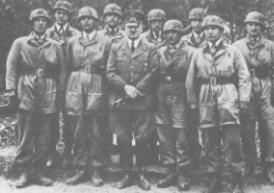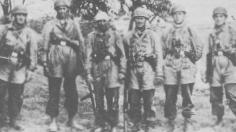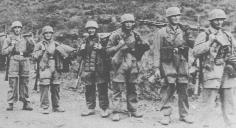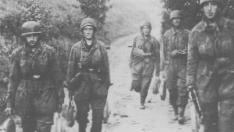

Joined the 16th Pioneer Battalion in Hoxter as an officer Candidate on April 1st, 1935. became a Leutnant on April 20th, 1937 and served as platoon leader in the 31st Pioneer Battalion, Hoxter. Reported as a volunteer to the parachute troops on August 1st, 1938 and joined the Parachute Infantry Battalion under Major Heidric. After transfering to the Luftwaffe, Witzig was an Oberlautnant and leader of the Koch Parachute Assualt Battalion's pioneer platoon. Promoted to Hauptmann on May 16th, 1940.
During operations in Crete, he led the 9th Company of the Parachute Assualt Regiment, where he was wounded. He was transfered to a Luftwaffe Hospital in Athens, and then to other Hospitals.
Became the CO of I Battalion, 21st Parachute Pioneer Battalion on June 15th, 1944 and at the same time was placed in charge of the Regiment. Witzig was again mentioned in a communique for adding in the destruction of 27 Allied tanks near Kumele.
In November of 1939 by the order of the Luftwaffe High Command, a special detachment composed of 3 airborne units called "Test Section Friedrichschafen." was formed. Within months, this unit's name was changed to "Assualt Battalion Koch." One of the principle units assigned was the Pioneer Platoon of 2nd Battalion commanded by Oberleutnant Rudolf Witzig.
It is Rudolf Witzig who this story is about. A man who became a household word with the stunning capture of Eben Emael. We will follow his path throughout the war.

The guns of the Belgian fortress of Eben Emael dominated the Albert Canal bridges. It was upon these bridges that the German Sixth army would need to cross to keep pace with the Panzers bent upon crushing the Franco-British armies in Belgium. Only with Fallschirmjager could a quick knock-out punch be delivered. The war in the west's timing and success literally depended on the 438 paratroopers of Assualt Battalion Koch. So important was the capture of Eben Emael and the adjacent bridges, that not until 5 minutes after the gliders touched down would the general assault by the German Army begin.
Inside the diamond shaped fortress of Eben Emael. It was covered by short-ranged guns for local defense and others for long range (such as twin and triple mount 75mm & 120mm guns plus support weapons such as 66mm anti-tank guns, machineguns and anti-aircraft guns), mutually supporting pillboxes and block houses that dominated the grounds and a garrison of approximately 1200 men. The man chosen to attack Eben Emael was Rudolf Witzig . Code-named "Granite" Witzig's Para Assault Engineers would take on the best that Belgium had to off with only 83 rank and file armed with personal weapons, 6 light machineguns, 16 medium machine guns, 58 carbines, 4 flame throwers, and 2.5 tons of explosive's loaded in 11 gliders.
Witzig next mission was as commander of 9.Kp/STURM Regiment for the attack on Crete; they landed in the Maleme area. The following is quoted (translated) from Kurowski's "Der Kampf um Kreta":
"The III.Battalion [ed. 9th, 10th, 11th, and 12th Companies] was dropped into the huge area in the Maleme-Pirgos region extending from the west of Platanias to Marina, south of Maleme [ed. extending from the east edge of the airfield to about 10 km further east]. Because the battalions sub-units were scattered, this phase of the operation was waistful. Having been dropped in the wrong place the battalion commander was unable to exert any influence on the battle. Nor were the company commanders of the 10th or 12th companies, as many of their men came down near enemy positions and were killed or wounded during their descent or almost as soon as they touched the ground [ed. 11th company was also ineffectual as they were very widely scattered]. Only elements of the 9th company [ed. dropped just east of the airfield] succeeded in getting to the rendezvous where the battalion was to come under the orders of the regimental commander [ed. the battalion was to attack the airfield supported by the two glider companies (1st and 2nd) that landed south and west of the airfield]. And in the course of their trek to this appointed rendezvous point the company commander, Hauptmann Witzig, was wounded. Some of the stragglers of the company were picked up a few days later when the Germans gained the upper hand and the regiment overran the terrain where groups of parachutists had continued to fight or hide."

Placed in command of the Corps Parachute Pioneer Battalion on May 10th, 1942. Promoted to Major on August 24th, 1942. Served in Tunisia in November within the Barenthin Luftwaffe Regiment. Helped greatly in the defensive operations in Northern Tunisia.

In the summer of 44, the German Army was dealt a shattering blow with the destruction of Army Group Center in Belorussia that June. As July went by, Russian spearheads were approaching the Baltic Sea. Of the units sent to halt the Russians, one was Witzig's 1st Para Engineer Battalion. Their story that day of a single battalion of Fallschirmjager holding off a complete Red Army Tank Division, would sweep through the Arny Group. In open ground, the individual companies took up positions on the road from Dunaburg to Kovno. No. 1 Company was north of the road, No. 2 Company to the south. No. 4 Company while understrengthed was attached to No 2. Company. No. 3 Company was not serving with the battalion.
Poorly equipped, the battalion did not have time to lay out a mine filed. The only support they could rely on were a few Panzerfausts, amd a one Panzerschreck per group of 4 men.
The Soviets opened up with an hour long artillery barrage, and through the smoke Russian infantry clung to the sides of tanks as they apporached the Fallschirmjager positions. The Jaeger of No. 1 Company held thier fire until the reds were 20 meters distant. Opening fire, the Jaeger swept the vehicles and tanks with machinegun fire killing the Russian infantry. Small groups of Jaeger raced among the tanks stalking them with Panzerfausts or high explosive charges. Wthin minutes, 15 Russian T-34's burned in the morning sun.
Then it was the Russians turn. The infantry charged forward into the massed fire of the Jaeger machineguns. The first Soviet attack had been halted. Of the Fallschirmjager left No. 1 Company counted just over 30 men to hold the positions.
Torwards the south, while the fighting wqs heavy, the Russian had been more successful. Russian tanks penetrated and passed through the Para positions cutting off the Dunaburg-Kovno road. The SP guns promised the Jaegers and which might have defeated the tanks had left along with the anti-tank guns.
With that support the Para position were no longer tenable. With Russians to their front, on their right flanks, and behind their positions, it was just a matter of withdrawing the forward platoons and regroupling them in the woods west of the village.
As the Jaeger made their way to the woods, the Russians who had broken through had been reinforced with infantry. They fired at any movement. No. 2 Company had to cross more than 2 kilometers of open ground to reach the safety of the woods. Not many made it. At the regroup line No 1 Company mustered 12 unwounded men in all, and from No. 2 Company only 10 men reached the line. Major Witzig lead the remnants of his Para Assualt Battalion through the thick woods, bupassing red positions until German lines were reached. Over the next few days. Determined Jaeger made their way back. Soon the battalion numbered 65 men and was back into action again until October when the unit was taken out of action, broken up, and dispersed among other units. Major Witzig was sent to the Western Front where he became CO of the 18th Parachute Regiment on December 16th, 1944. Major Witzig Surrendered on May 8th, 1945.
Sources:
